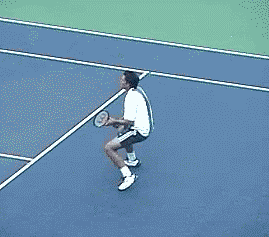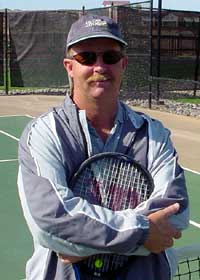|
TennisOne Lessons Avoiding Common Mistakes in Tennis The Volley Dave Smith
Last month in the first part of this series of 'common mistakes' in tennis, I addressed errors in serving that often lead to players' inability to make strides in producing better serves. Such errors are often detrimental not only to a player's ability to produce a proper or skilled stroke at the moment, but they are also detrimental to a player's ability to improve over time. In this article, I want to address common problems associated with the volley; problems that prevent the acquisition of both, more effective volleys, (pace, angle, depth, spin) as well as hitting better volleys off more effective shots by our opponents. Contact Point One of the most mentioned teaching phrases on the tennis court is "hit the ball out in front of you." While the context of this phrase (don't hit the ball late) is fairly well understood, the misunderstood application of the phrase causes numerous problems and detrimental consequences. If we look at skilled players volley, the contact point is seldom out in front of them-as in reaching forward towards the net. This is especially true on backhand volleys. The arm is seldom extended out towards the oncoming ball. In most cases, the arm is extended parallel to the net as the body is turned sideways. When we make a proper unit turn in preparing for a backhand volley, the arm is already in front. (The hitting shoulder is in front on the backhand volley.)
Assuming we don't take the racquet back with our arm-a common mistake among beginners and intermediate players-the racquet will be set to make contact right off the front knee or hip, the ideal contact point on the volley. It is when players take a back swing that pros can be heard correcting the student with the phrase, 'hit the ball in front of you.' This is because if you turn your shoulders and then take the racquet back with your arm, the racquet will usually be pointing back at the back fence. The timing of bringing the racquet back to meet the ball then usually requires a deceleration of the racquet and extraordinary timing. On forehands, because the hitting shoulder is back when we make the turn, players will want to consciously maintain the forward position of the hand so-as to not carry the racquet back parallel with the back hip. However, many beginners and intermediate players, (especially those who use eastern grips on their volley) tend reach too far forward to make contact. The problems, when you do try to reach forward to make contact with the ball, are numerous. And while such problems are usually subtle, they can contribute collectively to the overall prevention of a player's ability to improve their volley skills.
The first problem with reaching too far forward is the reduction of time. By reaching forward to contact the ball, instead of moving with the feet and waiting with the hands, you can lose about two feet of distance which you could have used to make better contact, set the angle of the racquet sooner, and/or provide a little more time to track the ball with our eyes.
The second problem lies with the fact that if you have your arm outstretched towards the on-coming ball, there is little-if any-swing left to hit the ball with! Players who reach forward to contact the ball often are seen using their wrist or body to hit the ball with more pace. This is because when you reach too far for the ball, the only way to create racquet head speed is to flip the wrist or lunge forward with the body. A third problem with reaching forward to the ball is balance. Anytime we reach forward with our racquet, our center of gravity becomes off-balanced. Players who do reach forward tend to be off-balance during contact or right after. Also, when a player reaches, their feet tend to stay still, causing this sense of off-balance to be emphasized. And when players reach with their hands, they can't move to get to balls a little further from them. John McEnroe had probably the best all-around volley because he almost always moved in a simple, vertical body alignment. That is, he would move his feet and seldom reach out for the ball, keeping him both up right and balanced during and after every ball. There can't be enough said about the importance of the grip in the volley. While there are some embellishments among skilled players, the vast majority of them use the continental grip to hit their forehand and backhand volleys. But, perhaps more important than what the skilled players use for their grip, the issue of players looking to learn to volley well, is greatly effected by the grip they choose.
In my thirty years, there is nothing that stands out more in my mind than the clear difference between those who try to learn the volley using the more simplistic eastern forehand and backhand grips and those who learn from the start to volley with the continental grip. I personally feel that anyone who promotes learning the volley with the eastern grips is seriously preventing the long-term potential and advancement of the student. There are numerous reasons for this:
Hitting the Volley Flat The most incriminating factor that encourages players to 'dink' their volley is their attempt to hit the ball flat. If you watch skilled players, you will notice in almost every instance, there is some element of underspin or slice applied to the volley. (Exceptions to this are a higher volley that is close to the net or the more advanced swinging topspin volley, which resembles a groundstroke more than a conventional volley!) There are many problems that arise when a player attempts to hit volleys flat, (even high ones).
Problems hitting flat:
Bent Arm Backhand volleys are difficult to learn and master. One of the contributing elements of difficulty is what I call the 'bent elbow syndrome'. That is, when a player turns for the backhand volley, the natural tendency is for the elbow to bend. The problem with players who have not mastered the volley is that they tend to straighten the elbow to make contact. If you look at most all skilled players, during the backswing, (or well before contact), the hitting arm locks firm and straight. (Observe the various backhand volleys in this and any other article and you will see this feature among almost all skilled players.) I won't get into the physics of why this is important. What I will say is that when players bend the elbow, they tend to swing too big for one thing; they also lose power and control due to having to control the aspect of the elbow in addition to the other stroke components. Players who learn to maintain a conscious and firm elbow position from start to finish on the backhand volley gain mastery of the shot faster and with more effective volleys. Conclusion There are many excellent articles on how to hit the volley correctly found here at TennisONE. If you combine the understanding of how to execute the volley well, with your understanding of these common mistakes presented here, you will be well on your way to learning to volley skillfully. Like anything worth doing, it may take time to master the volley under these criteria. Yet, you will enjoy a lifetime of playing the net well and effective! (Instead of a lifetime of wishing you could make just a couple of clean volleys.) Your comments are welcome. Let us know what you think about Dave Smith's article by emailing us here at TennisOne .
TENNIS MASTERYFinally. a resource that unlocks these mysteries: • Why do m • Why are making changes in one's game so frustratingly difficult? • What tennis teaching methods are disruptive or detrimental to player progression? Read David W. Smith's TENNIS MASTERY and learn not just how to avoid playing at mediocre levels, but how the best players in the world Master the sport of tennis! "With a depth of knowledge and fresh perspective, TENNIS MASTERY is set to become a manual for tennis instructors and a measure for tennis literature." Richard Wigley, Director, Kayenta Tennis Center , Ivins Utah . Take in David Smith's 30 plus years in the tennis teaching industry. This 335-page manual will provide for every level of player as well as support for all tennis-teaching professionals, a blueprint for reaching higher levels of tennis mastery. Order TENNIS MASTERY at tenniswarehouse.com , or go to tennismastery.net for exciting excerpts from the book and a host of tennis information! And check out David Smith's other articles found here at TennisONE.com David has taught over 3000 players including many top national and world ranked players. He can be reached at acrpres1@email.msn.com. |










 illions of tennis players stagnate at levels far below their potential?
illions of tennis players stagnate at levels far below their potential?  Your comments are welcome. Let us know what you think about this article by
Your comments are welcome. Let us know what you think about this article by